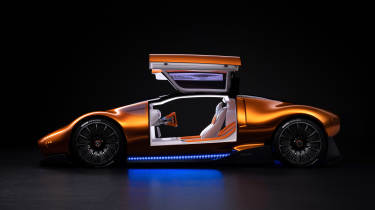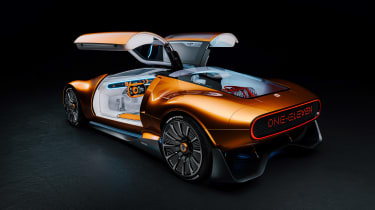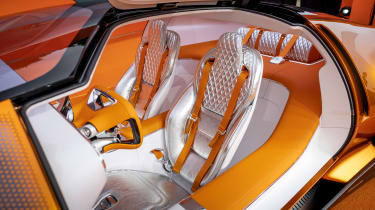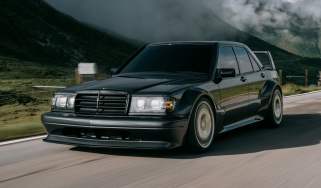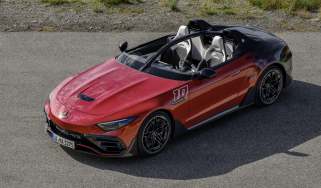New Mercedes Vision One-Eleven concept answers Porsche Mission X
The new Mercedes Vision One-Eleven concept car previews genuine substance under its skin, with technology set to power Mercedes-AMG’s new sports car due in 2025.
Mercedes has rolled out the latest in its series of Vision concept cars. The Mercedes Vision One-Eleven is a retro-futuristic gull-wing doored supercar with clear links to the influential Mercedes C111 models of the late 1960s and 1970s. While the design might hark back to the past, the technology within is very much looking towards Mercedes-AMG’s future, just as Porsche’s new Mission X concept provides a window into its future super and hypercar aspirations.
And while the Mission X is very much focused on the hypercar market, the One-Eleven harbours Mercedes’ next generation electric performance car powertrain with battery and motor tech that will appear in a more accessible electric Mercedes-AMG sports car due in 2025.
While the Bruno Sacco designed bodywork of the Mercedes C111 did more than enough to turn heads, the cars were primarily test beds for new engine technology. The 16 examples included 13 with Wankel rotary power, a V8 petrol engine and two straight-five turbo diesels, one of which hit 200mph at Nardo in 1978 setting a diesel engine speed record. Today, the Mercedes Vision One-Eleven inherits more than its bright orange colour scheme from the C111, debuting the powertrain tech that will propel Mercedes and Mercedes-AMG beyond 2035.
That technology is British, too. The Mercedes Vision One-Eleven’s electric motors are of the axial-flux variety, smaller and lighter than the current industry standard radial-flux units. They’ve been developed by YASA, the Oxford-based EV motor specialist that was bought by Mercedes in 2021 having supplied motors for Ferrari’s SF90 Stradale hypercar.
At around a third of the size of a conventional radial-flux motor, the YASA motors have a distinct packaging advantage and, with further development, could be housed within a car’s wheels - four motors for all-wheel drive. They also bring power and torque advantages with YASA CEO, Tim Woolmer stating that; “Compared to radial-flux motors, they have considerably higher and more enduring power reserves, which delivers a whole new level of performance.”
There’s more, too. The Vision One-Eleven’s battery comes out of Mercedes-AMG High Performance Powertrain in Brixworth, Northamptonshire - the creators of Mercedes’ F1 engines that also powers the Amg One hypercar. The innovative liquid-cooled cylindrical cells have a unique chemistry designed for high performance and along with the YASA motors, these batteries are expected to make production.
What we’re unlikely to see is much of the Mercedes Vision One-Eleven’s design making its way to a road car. Mercedes chief design officer Gorden Wagener confirmed the retro themes behind his creation: “Design icons like the Type 300 SL and C 111 – both with gullwing doors – are part of our DNA. These legendary vehicles were major inspirations for the iconic design of the Mercedes-Benz Vision One-Eleven.
“Our all-electric vision show car is the modern-day interpretation of the C 111, which was avant-garde at the time.”
The new car has what Wagener describes as a “one-bow” design, no detail lines, “super-simple and super-sexy”. The C11’s wide grille is clearly referenced at the front by a digital panel that uses 3D pixels to create circular headlamps. At the back, sandwiched between a curved rear wing and a huge splitter, a similar screen used those pixels to spell out the ‘One Eleven’ legend and is completely encircled by a red light bar.
The interior too, is not exactly what you would call production ready, finished in ‘sustainable’ silver leather, with minimal switchgear and an orange yoke-style steering wheel. Mercedes did, however, reveal a separate mock-up of the cabin with a new augmented reality control system where occupants don a Virtual Reality headset that turns the whole interior into a control interface with 3D icons for key functions and directions apparently projected onto the road ahead.
Speaking to evo at the launch event for the Vision One-Eleven, Mercedes’ chief technology officer, Markus Schäfer, confirmed the production relevance of the technology and that the concept car is much more than a static demonstrator.
“Best case, the whole car goes into series production, but my minimum requirement is the components will go into series cars – that's exactly what's happening with the EQXX and I'm going to deliver the proof points. So now we're going to cover the performance side of the house.”
When it was pointed out that the C111 and the EQXX set world records for performance and efficiency, Schafer said: “Yes. That's the plan to deliver a record with the orange car as well.”
And as for the development and focus of Mercedes-AMG in the electrified future, he sees the days of the benchmark acceleration figures being numbered in high-end performance models. “I think it doesn't make a difference if it's 1.9, 2.0 or 2.2 seconds – do you really feel the difference anymore? Maybe between 4 seconds or 3.5 and a 2.2, yeah, you would probably feel something. But can you really experience it day-to-day? When would you do that? So we’re thinking about another format to show the performance of the car. It's a combination and charging is part of the equation in the future, really ultrafast charging, plus acceleration, plus torque, plus feel.”

